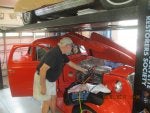The ongoing saga of "issues" with the VA system in my 37 coupe goes on. I know that this problem is not on my Tri-Five, but I'm hoping to get some answers here.
My buddy with the professional gauges has been unable to make it over to the house to help me out, so the car is just sitting.
I was advised to put a new dryer in the system. I bought one, identical to the one in the car.
I removed the old dryer and plugged the IN and OUT lines to it.
Turned the old dryer upside down... and hardly any oil came out. I might have gotten a drop or two... that's it.
I can't get a consistent answer. Some say to add 2 oz. to the dryer directly. That new PAG oil would have to be added through the IN or OUT fitting.
2 oz seems like a lot... that would be 2 shot glasses full.
Any advice?
The system has a Sanden 508 compressor, which I have learned has 5 oz of oil from the factory , and that is meant to lubricate the entire system when new.
My buddy with the professional gauges has been unable to make it over to the house to help me out, so the car is just sitting.
I was advised to put a new dryer in the system. I bought one, identical to the one in the car.
I removed the old dryer and plugged the IN and OUT lines to it.
Turned the old dryer upside down... and hardly any oil came out. I might have gotten a drop or two... that's it.
I can't get a consistent answer. Some say to add 2 oz. to the dryer directly. That new PAG oil would have to be added through the IN or OUT fitting.
2 oz seems like a lot... that would be 2 shot glasses full.
Any advice?
The system has a Sanden 508 compressor, which I have learned has 5 oz of oil from the factory , and that is meant to lubricate the entire system when new.





